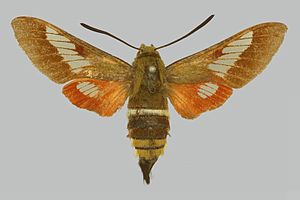Hemaris ducalis
| Hemaris ducalis | ||||||||||||
|---|---|---|---|---|---|---|---|---|---|---|---|---|

Preparation of a female |
||||||||||||
| Systematics | ||||||||||||
|
||||||||||||
| Scientific name | ||||||||||||
| Hemaris ducalis | ||||||||||||
| ( Staudinger , 1887) |
Hemaris ducalis is a butterfly ( moth ) from the family of moth (Sphingidae). Due to their similar morphology and habitat requirements, it can be assumed that the species is very closely related to Hemaris dentata .
features
butterfly
The moths have a wingspan of 40 to 50 millimeters. They can be distinguished from all other species of the genus Hemaris by their cream-colored band on the back of the third abdominal segment. The extent of the transparent areas on both pairs of wings is variable. The species has no arolium . The upper side of the hind wings is completely orange, apart from the transparent areas. The front wings, on the other hand, have a rather brown color on the upper side. The species can also be distinguished from Hemaris dentata by the fact that its fore wings are almost completely scaly, the third abdominal segment is yellowish-white in color and a brown color is limited to the tufts of hair at the end of the abdomen and pulvilli are missing.
Forma efenestralis is characterized by the fact that the transparent areas of the forewings are partially covered by dark scales on the side towards the outer edge of the wing. The hind wings have no transparent areas at all. The Forma lukhtanovi is similarly colored, but has only very small transparent areas on the forewings . According to Rothschild & Jordan (1903), the males of the species can be easily identified on the basis of their sexual organs. The left valves are slimmer than in Hemaris tityus and resemble those of Hemaris fuciformis . The process of the left saccule consists of a conspicuous, thorny hump. The right valves are slightly ventrally outlined beyond the center . The process of the right saccule is long, slender and somewhat club-shaped. The top on the apical half is proven with long thorns. The Juxta is pretty densely covered with long hair at the tip. The aedeagus is quite long and not very pointed.
Caterpillar
The caterpillars are 33 to 42 millimeters long. Only the fully grown caterpillars are described. They resemble those of Hemaris fuciformis and are pale green on the back and sides and bear a conspicuous yellowish-white line that runs from the first segment of the thorax up to the slightly curved anal horn . Unlike the similar species, Hemaris ducalis has a line of pale, yellow, V-shaped spots on its back that point backwards and one of which is on each segment and which are less noticeable on the thoracic segments. On the ventral side, the caterpillars are reddish-brown in color and have a fine, light yellow longitudinal line ventro-laterally, which separates the dark underside from the green upper side. The line is thicker and darker at the level of the abdomen . The belly legs themselves are brownish-cream in color. The anal horn is five millimeters long, blackish-purple at the base and whitish-green or cream-colored towards the tapering tip. As with Hemaris fuciformis , the rounded head is bluish-gray and has a strongly contrasting, cadmium-yellow first thorax segment as a "collar". An equally colored line flanks the sides of the pushers . The entire head, body and anal horn are provided with pale tubercles. They are light yellow on the back and cream-colored below the dorso-lateral longitudinal line. The oval stigmas are reddish-brown and cream-colored.
Occurrence and habitat
The species is found in the Hissar Mountains in southern Uzbekistan , southern and eastern Kazakhstan to the Altai , Tajikistan , Kyrgyzstan , the Ulungur Valley (Bulgan-gol) in western Mongolia , the Chinese part of Tian Shan , the mountainous region in the southwest of Xinjiang , the Pamir , northern and central Afghanistan and northern Pakistan as far as Ladakh . There is also an isolated occurrence between 2,400 and 4,000 meters above sea level in Gilgit and Ziarat , in Pakistan.
Forests and bushes are populated, only rarely below 2000 meters above sea level, up to 4000 meters above sea level. In western Mongolia the moths are found at 2100 meters above sea level, in eastern Kyrgyzstan at 1300 meters and in central Afghanistan at 2900 meters above sea level.
Way of life
The moths are diurnal and fly in one generation from mid-June to early August. In southern Kazakhstan, western Mongolia and eastern Kyrgyzstan, the moths are usually found from mid-June to mid-July. There are no known parasitoids that infect the species. The caterpillars occur from July to September. They feed on most species of the honeysuckle ( Lonicera ), such as Lonicera korolkowii , Lonicera nummulariifolia , Lonicera seravschanica or Lonicera stenantha . The approximately 37 millimeter long doll is black-brown and has a rough surface. It is very similar to that of Hemaris fuciformis . The pupa hibernates. The eggs are unknown.
Taxonomy and systematics
The species was described by Otto Staudinger in 1887 as Macroglossa ducalis . The subspecies Hemaris ducalis dantchenkoi Eitschberger & Lukhtanov, 1996 from central Afghanistan, described by Eitschberger & Lukhtanov (1996), is not a valid subspecies, as these animals are a high altitude, montane form of Hemaris ducalis that already exists In 1984 it was described by Derzhavets as Forma efenestralis . The subspecies Hemaris ducalis lukhtanovi Danner, Eitschberger & Surholt, 1998 is doubtful according to Kitching & Cadiou, (2000). Normally colored individuals of Macroglossa ducalis , lukhtanovi specimens and hybrid forms occur together in central Afghanistan, so that it can be assumed that it cannot be an independent subspecies.
supporting documents
Individual evidence
- ↑ Hemaris DENTATA (Staudinger, 1887). AR Pittaway: Sphingidae of the Western Palaearctic, accessed December 26, 2014 .
- ↑ a b c d e f g HEMARIS DUCALIS (Staudinger, 1887). AR Pittaway: Sphingidae of the Western Palaearctic, accessed December 26, 2014 .
